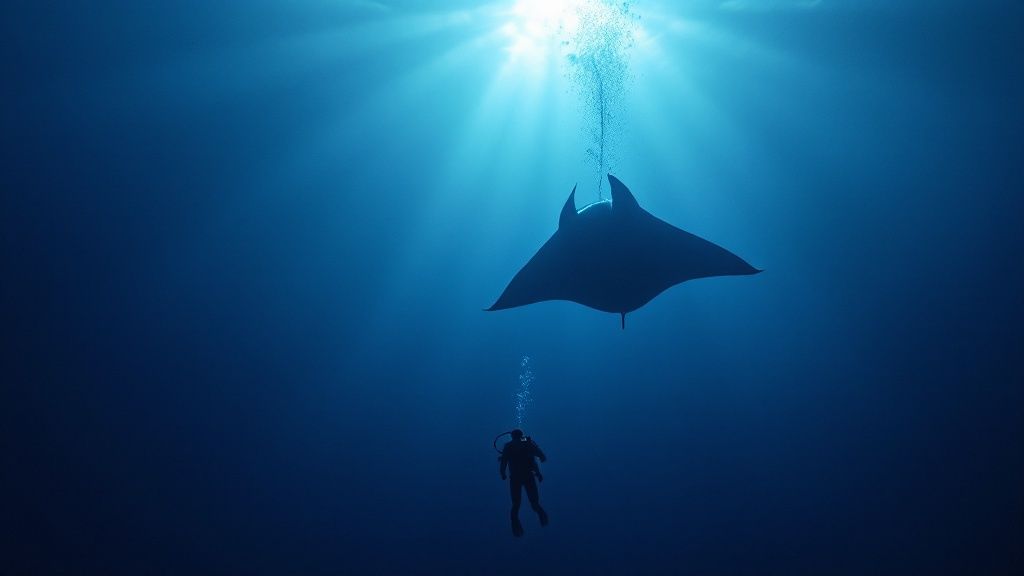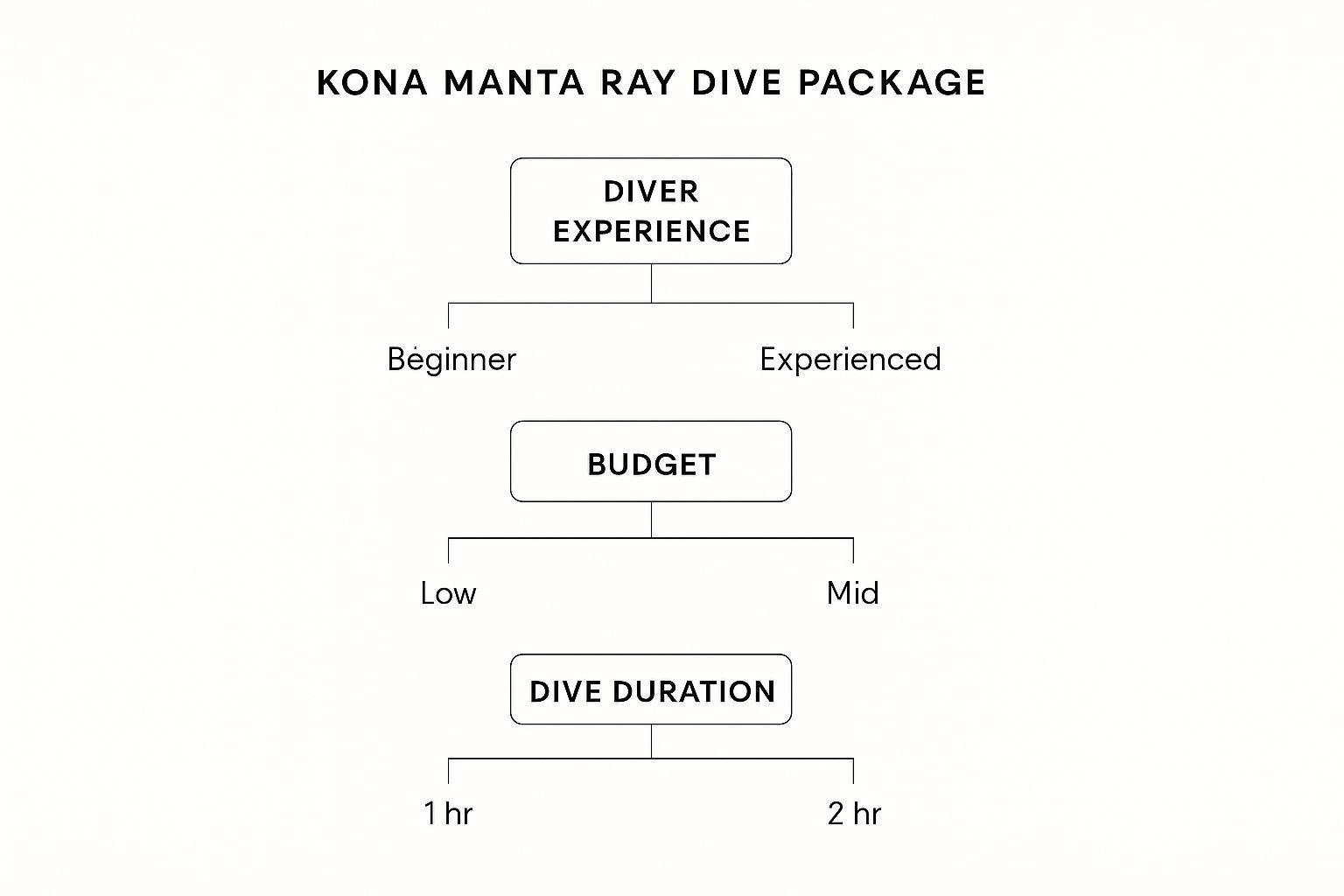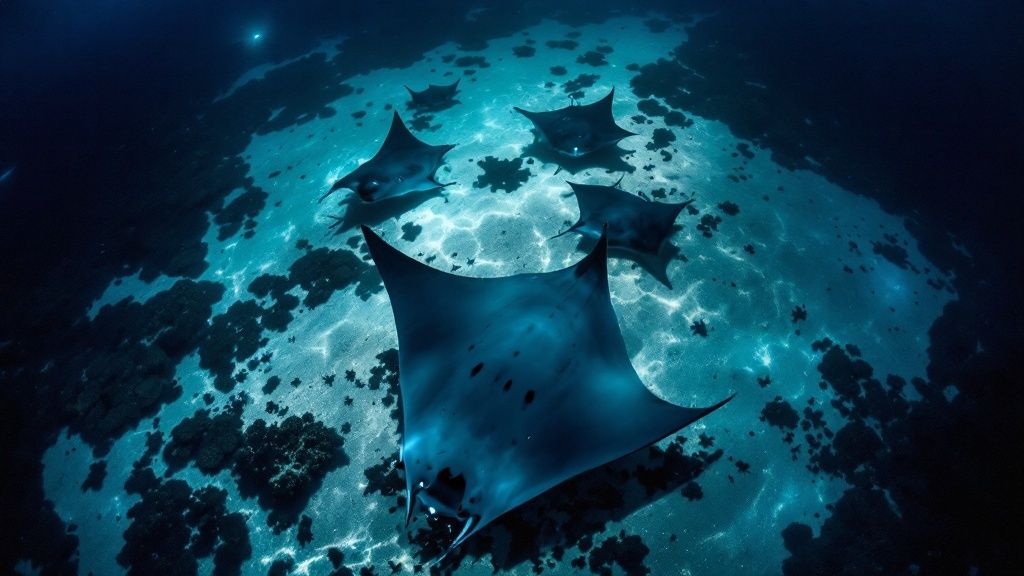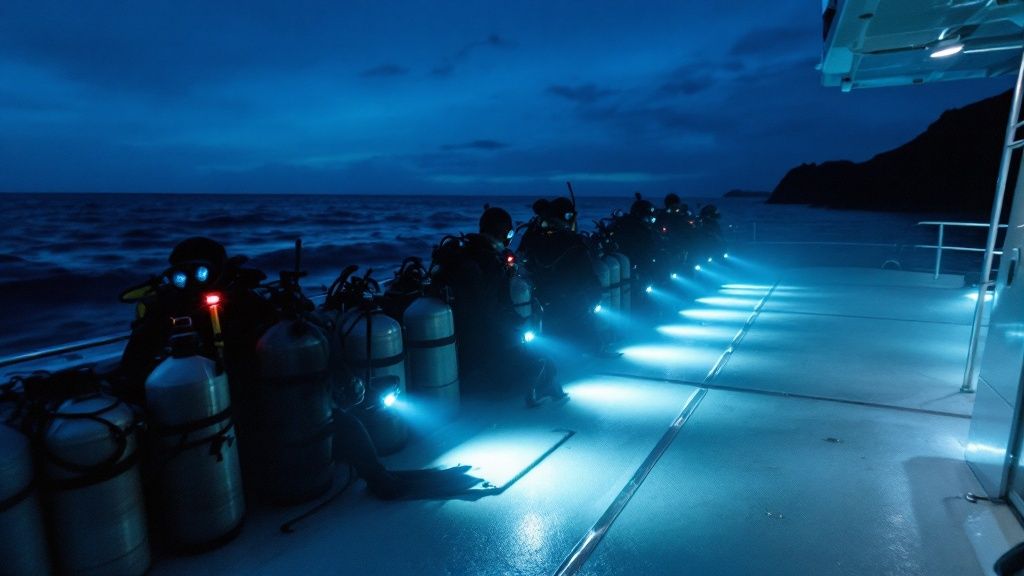The Magic of Kona: Your Gateway to Manta Ray Encounters
Kona, Hawaii, is more than just a beautiful island; it's a world-renowned destination for incredible manta ray encounters. The unique blend of geographical features and ocean currents creates a haven for these gentle giants, drawing divers and snorkelers eager to witness their grace in the wild. Intrigued? Learn more about why you should experience a manta ray dive in Kona.
The Nutrient-Rich Waters of Kona
Kona's manta ray magic stems from its nutrient-rich waters. Volcanic activity and upwelling currents bring vital nutrients to the surface, creating thriving plankton blooms. These blooms become a feast for manta rays, drawing them in night after night. This reliable food source makes Kona one of the most consistent locations globally to observe manta rays.
Manta Heaven and Manta Village: Hotspots of Activity
Years of local knowledge and research have identified specific locations where mantas gather to feed. Two sites, Manta Heaven and Manta Village, are particularly famous. These aren't just clever names; they represent areas with remarkably consistent manta ray sightings. The Kona Coast on the Big Island of Hawaii is known worldwide as a top manta ray diving and snorkeling destination.
Between 2009 and 2014, researchers carefully tracked manta ray sightings at these sites. They documented an impressive 50 to 150 manta ray encounters per dive each month. Kona's plankton-rich currents, a magnet for these filter-feeding giants, explain this remarkable consistency. This data highlights Kona's importance as a manta ray habitat and informs ongoing conservation efforts. More detailed statistics can be found here.
A Sustainable Tourism Model
The consistent presence of manta rays has established Kona as a manta ray dive hotspot, boosting the local economy and driving vital conservation work. Dive operators recognize the importance of safeguarding this delicate ecosystem and have adopted sustainable practices. These practices minimize their impact and contribute to a cycle where tourism and conservation work in harmony, ensuring future generations can experience the wonder of Kona's manta rays. For a longer stay, consider a side trip to Luxury Holiday Rentals Spain.

Planning Your Perfect Manta Ray Dive Kona Experience
Turning your Hawaiian vacation into an unforgettable manta ray experience takes careful planning. Picking the right time of year, tour operator, and dive type ensures a magical encounter. This means understanding your options and preparing for the unique conditions of a manta ray dive.
Choosing the Right Time and Operator
Kona has fantastic manta ray dive opportunities year-round, but visibility and manta activity vary seasonally. Local dive operators can suggest the best time to visit, often coinciding with calmer waters and increased plankton. Choosing a reputable operator is equally important. Prioritize operators with strong safety records and genuine conservation commitments. Avoid those who seem to prioritize profit over the mantas' well-being.
Matching Your Experience Level to the Right Dive
Manta ray encounters cater to everyone from beginner snorkelers to seasoned divers. Beginner-friendly snorkel tours offer an excellent introduction, while experienced divers can explore deeper for more intimate interactions. Learn more in our article about freediving gear. You might also be interested in: How to master freediving. Carefully evaluate your comfort level and choose a dive that aligns with your skills and experience.
Practical Planning and Preparation
Booking in advance is essential, especially during peak season. Secure your spot early to avoid disappointment. If you are prone to seasickness, take precautions before heading out. Preparing your camera equipment beforehand ensures you are ready to capture the breathtaking moments.

The infographic above offers a simple decision tree for choosing a Kona manta ray dive package based on experience and budget. As shown, beginners on a budget might select a 1-hour snorkel tour, while experienced divers with a larger budget could choose an extended 2-hour dive.
To help you compare various options, we've compiled the following table:
To help you choose the right experience, the table below details the different Manta Ray Dive options available in Kona.
| Experience Type | Requirements | Typical Duration | Best For | Average Cost |
|---|---|---|---|---|
| Snorkel Tour | None | 1 hour | Beginners, budget-conscious | $100-$150 |
| Introductory Dive | Basic swimming skills | 1-1.5 hours | First-time divers, families | $150-$200 |
| Night Dive | Open Water certification | 1.5-2 hours | Experienced divers | $200-$250 |
| Private Charter | Varies | Customizable | Groups, special occasions | $500+ |
This table highlights the key differences in required experience, duration, and cost, allowing you to tailor your trip to your specific needs and budget. Remember that private charters offer the greatest flexibility.
Physical and Mental Preparation for the Dive
Beyond the practical, physical and mental preparation enhances your manta ray dive Kona experience. Being physically fit improves your comfort and endurance in the water. Mentally preparing for a night dive reduces anxiety and allows you to appreciate the magic. This might involve visualizing the experience, familiarizing yourself with night diving practices, or practicing relaxation techniques. A relaxed and prepared diver is best equipped to enjoy these graceful creatures.
Beneath the Moonlight: Anatomy of a Manta Ray Night Dive

Preparing for a manta ray night dive in Kona is an adventure in itself. The excitement builds from the initial briefing to the moment you slip into the dark ocean. This guide will walk you through each step, giving you a glimpse of what awaits. For a more detailed look, check out our guide on Manta Ray Night Dive in Kona, Hawaii.
Shore Preparations and Descent
Your adventure starts with a comprehensive briefing on the shore. Dive operators typically cover the dive plan, safety procedures, and manta ray etiquette. This is your chance to ask questions and address any concerns you might have.
Once the briefing is complete, it’s time to gear up and enter the water, usually from a boat anchored near the dive site. The initial descent into the darkness can be a little disorienting. Trust your guide, focus on equalizing your ears, and enjoy the anticipation.
The Campfire Formation and Light Placement
On the ocean floor, divers typically form a "campfire" circle. Everyone kneels around a central light source, facing outwards. This arrangement maximizes the viewing area for all divers and minimizes disturbance to the mantas.
Powerful lights, strategically placed above the circle, attract plankton. This creates a mesmerizing underwater feast, the main attraction for the manta rays.
Sensory Experiences in the Dark
Night diving is a completely different sensory experience than diving during the day. The darkness heightens your other senses. Sounds become more pronounced, and you’ll feel the water against your skin in a whole new way.
The beams of light piercing the darkness create an ethereal atmosphere, illuminating the graceful silhouettes of the approaching manta rays.
Manta Ray Etiquette and Responsible Viewing
When the mantas arrive and begin their elegant feeding dance, it’s crucial to practice responsible viewing. This means no touching the mantas and no obstructing their movement.
Maintaining proper buoyancy control is vital. This prevents accidental contact with the ocean floor or, more importantly, with the mantas themselves. These simple guidelines ensure the safety and well-being of both divers and these magnificent creatures.
Ascending and Post-Dive Reflections
After an unforgettable experience, the ascent is slow and controlled. The memory of being surrounded by these gentle giants in the dark ocean will likely stay with you long after you surface.
Many divers describe manta ray night dives as the most incredible underwater experience of their lives. Your post-dive conversations will undoubtedly be filled with awe and wonder for these majestic creatures and the magic of Kona's underwater world.
Meet Kona's Manta Ray Celebrities: Stars of the Show
After the excitement of a night dive, let's focus on the true stars: the manta rays. These aren't just nameless shadows moving through the ocean; they are unique individuals, each with distinct personalities, life stories, and even names.
Identifying Kona's Mantas: Nature's Fingerprints
Researchers use remarkable techniques to identify and monitor these graceful ocean wanderers. Just like our fingerprints, each manta ray has a unique pattern of markings on its belly. These patterns allow scientists to catalog and track each manta, studying their movements, migrations, and even their social interactions.
The manta ray population around Kona is particularly well-documented, with over 290 individuals cataloged. The first manta ever identified, appropriately named ‘Lefty,’ became the foundation for this photographic identification method. Long-term tracking has uncovered fascinating insights, such as the strong site fidelity displayed by certain mantas. Some, like ‘Big Bertha,’ have been observed at the same feeding grounds for decades. Learn more about manta ray facts.
Famous Faces: Lefty, Big Bertha, and More
This careful tracking allows divers in Kona to encounter some of the ocean's most famous personalities. ‘Lefty,’ the local legend, is readily identifiable by his distinctive markings. ‘Big Bertha,’ another familiar face, has amazed divers for years with her sheer size. While the largest manta ray ever recorded measured an incredible 22 feet (7 meters) across, Kona’s reef mantas usually measure between 12 to 14 feet (3 to 5 meters) – still a breathtaking sight. These encounters add a deeply personal element to the manta ray dive Kona experience.
Your Photos: Contributing to Manta Ray Research
Your vacation photos can actually play a part in ongoing research. By sharing pictures of manta ray bellies with research organizations, you help track individual movements, monitor population trends, and assess overall manta ray health. Your travel memories become valuable scientific data.
Manta Intelligence and Social Behavior
Beyond individual identification, research is uncovering amazing insights into manta intelligence and social dynamics. These creatures display sophisticated communication and problem-solving skills, challenging our perceptions of marine life. They have complex social interactions, engage in playful behaviors, and even appear to recognize individual divers.
These discoveries underscore the importance of continued research and conservation. Your participation in citizen science initiatives is crucial for protecting these magnificent animals. By selecting reputable dive operators like Kona Honu Divers, you support conservation work and contribute to a sustainable future for Kona’s manta rays.
Conservation in Action: Protecting Kona's Manta Magic

Beyond the magic of a manta ray dive in Kona, lies a compelling story of conservation. Kona has successfully intertwined tourism and environmental protection, creating a model for marine wildlife tourism around the world. This achievement highlights the dedication of marine biologists, local advocates, and responsible dive operators.
Research Programs Fueling Conservation
Many Kona dive operators actively support and participate in cutting-edge research. These programs focus on understanding manta ray behavior, migration patterns, and population dynamics. This data informs practical conservation strategies. For example, information on manta ray movements helps define protected zones and create regulations for boat traffic. For more information on manta ray regulations, check out this open letter.
Protective Regulations Based on Science
Scientific discoveries directly shape the protective regulations for manta rays in Kona. Rules like restricted boat speeds and minimum approach distances are derived from research data. These measures minimize human impact, ensuring sustainable interactions with these gentle giants. Limiting the number of boats allowed at dive sites further reduces stress on the mantas and their habitat.
Collaboration Across the Industry
Kona's conservation efforts are remarkable for the level of cooperation between competing businesses. Dive operators, acknowledging their shared reliance on healthy manta ray populations, have joined forces for protection. They share best practices, contribute to joint conservation initiatives, and advocate for stronger regulations. This unified front ensures consistent manta ray protection across the industry.
Citizen Science: Tourists Becoming Researchers
Manta ray diving and snorkeling draw approximately 80,000 visitors to Kona annually, making it a global ecotourism hotspot. Visitors often partake in night dives, where lights attract plankton, the manta rays' main food source, creating stunning close encounters. Detailed statistics on manta ray tourism highlight this thriving industry. This creates unique opportunities for citizen science. Guided by researchers and dive operators, tourists contribute to data collection. For example, submitting photos of manta ray bellies helps track individual mantas and contributes to long-term population studies.
Thoughtful Practices Setting New Standards
Kona's dive operators are pioneering responsible marine wildlife tourism globally. This includes implementing strict codes of conduct, educating divers about manta ray etiquette, and minimizing their environmental impact. This sustainability focus protects the manta rays and enhances the visitor experience.
The following table provides an overview of various initiatives working to protect manta rays in Kona, and how visitors can get involved.
Manta Ray Conservation Initiatives in Kona
Overview of key conservation programs and how visitors can contribute to manta ray protection efforts
| Initiative | Organization | Focus Area | How Visitors Can Help |
|---|---|---|---|
| Manta Ray Identification & Tracking | Manta Pacific Research Foundation | Research, Conservation, Education | Submit photos of manta ray bellies for identification, participate in educational programs |
| Conservation & Education Programs | Kona Honu Divers | Sustainable Dive Practices, Public Awareness | Choose responsible dive operators, follow guidelines during dives, support conservation initiatives |
| Advocacy for Protective Regulations | Marine Mammal Commission | Policy & Legislation | Support organizations advocating for stronger protections for manta rays |
This table summarizes some of the key organizations and their work to conserve manta rays in Kona. Visitors can play an important role by supporting these groups and following responsible tourism practices.
Your Impact: Making a Difference
As a visitor, your choices matter. Choosing responsible operators, adhering to wildlife guidelines, and supporting conservation efforts makes you a part of the solution. Your actions, combined with ongoing research and collaborative conservation, ensure these incredible creatures will continue to grace Kona's waters.
Beyond the Dive: Crafting Your Complete Manta Adventure
A manta ray night dive is an unforgettable experience, but it doesn't have to be the only highlight of your Kona adventure. With a little planning, you can build an entire Hawaiian getaway around this magical encounter.
Daytime Delights: Complementing Your Night Dive
After the mesmerizing manta ray night dive, Kona offers a wealth of daytime activities. Explore the vibrant coastline with a dolphin swim, interacting with these intelligent creatures in their natural environment. Or discover hidden snorkeling spots teeming with colorful fish and graceful sea turtles. These daytime excursions perfectly complement the nighttime manta ray spectacle. Want to know the ideal time to see these gentle giants? Check out this helpful guide: What is the best time of year to see manta rays in Kona?
Cultural Connections: Deepening Your Appreciation
Immerse yourself in Hawaiian culture to enrich your Kona manta ray experience. Visiting historical sites or attending cultural events will provide a deeper understanding of the island's profound connection to the ocean. This will enhance your appreciation for the marine environment and the cultural significance of manta rays. Even beyond your in-person encounter, technology can deepen your connection to art; learn how converting art images into 3D models can create new perspectives.
Logistics Made Easy: Streamlining Your Trip
Smart planning is crucial for a stress-free vacation. Choosing accommodations close to your manta ray dive departure points minimizes travel time and maximizes relaxation. Ask local experts and dive masters for recommendations on oceanfront restaurants where you can savor the memories of your underwater adventures. Familiarize yourself with local transportation options—from car rentals and ride-sharing services to public transport—to easily explore the island at your own pace.
Packing Smart: Essentials for a Smooth Experience
Packing strategically ensures you're prepared for both daytime and nighttime activities. Essentials include swimwear, reef-safe sunscreen, a light jacket for the cooler evenings, and a waterproof bag to protect your valuables. Don't forget an underwater camera or consider renting a GoPro to capture the magic of your manta ray dives.
The Perfect Balance: Rest and Adventure
While it's tempting to pack your itinerary, remember to prioritize rest. Getting enough sleep is vital for fully enjoying each night dive. Balance your adventurous pursuits with relaxing activities like exploring local beaches, indulging in spa treatments, or simply unwinding by the ocean. This ensures you're refreshed and ready for each manta ray encounter.
Crafting Your Ideal Itinerary
The best Kona adventure is one designed around your personal preferences. Do you crave non-stop activity or a more relaxed pace? Are you a solo traveler, exploring with family, or adventuring with friends? These factors play a key role in crafting your ideal itinerary. Choose the elements that resonate with you most to create a personalized and memorable experience.
Book your unforgettable manta ray adventure with Kona Honu Divers today. Witness the magic of these gentle giants beneath the Hawaiian moonlight, and create memories that will last a lifetime.
